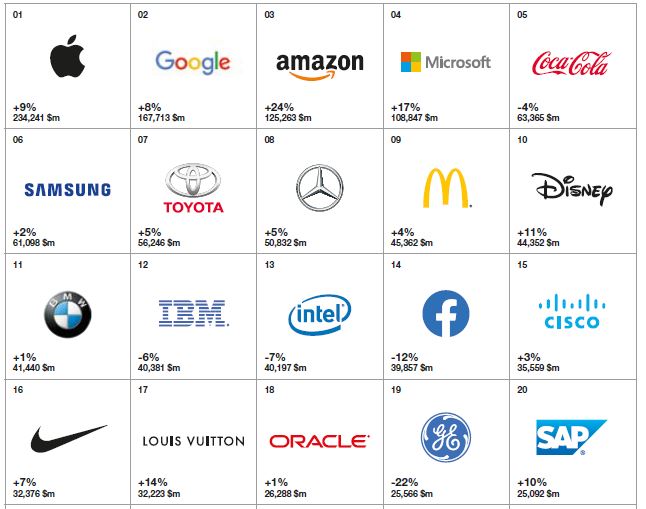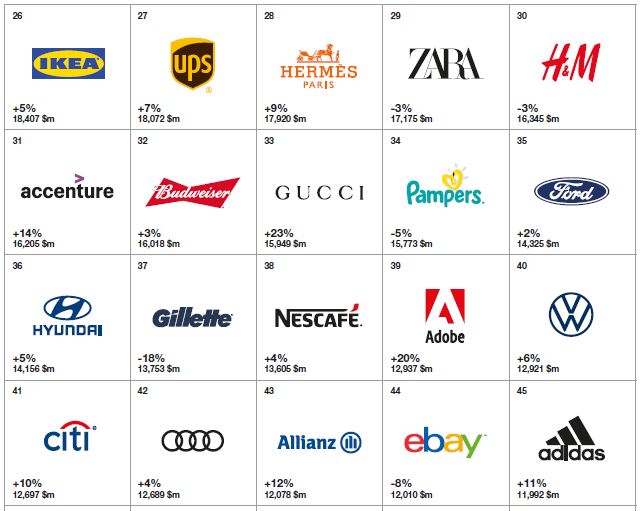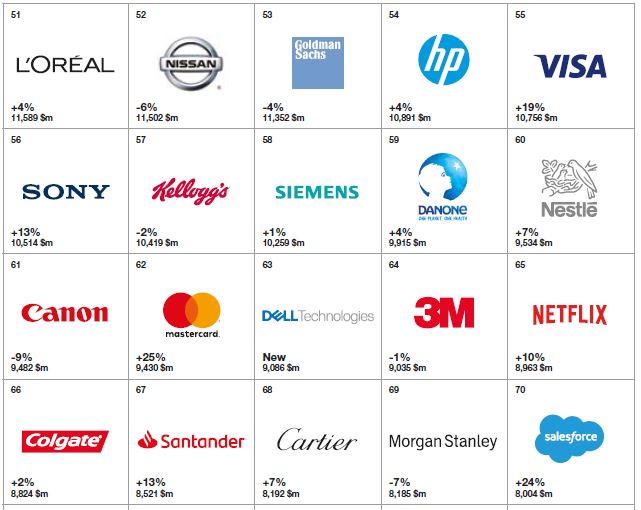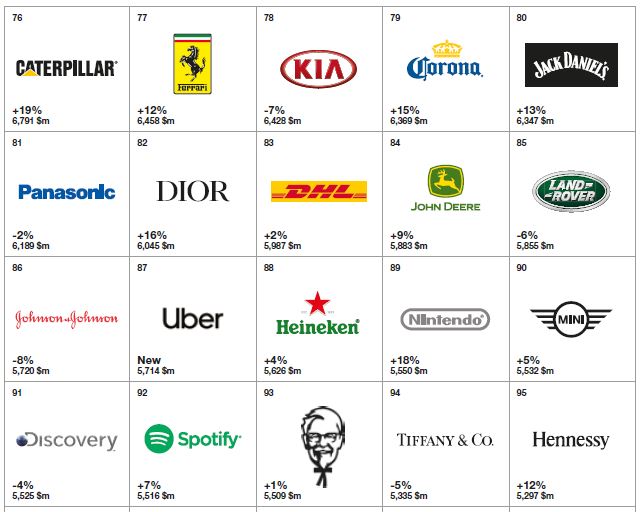Now this year’s Global Top 100 brands according to Interbrand have just been released and their major topic this year is “the end of positioning a move to “Iconic Moves”.
Since this is such an interesting read it’s basically all here. Its a newer more modern approach to the changing landscape we as marketers face.
The summary is bascially this: “With the end of positioning, our role at Interbrand (and for all marketers) will be less about helping define what a business stands for, and more about determining where it should go next — and making those Iconic Moves to get there quickly.”
It will take a combination of long-term clarity and short-term agility.
Here an overview of the Top 100 in 2019:
“Iconic moves”
In recently celebrating the fiftieth anniversary of the Apollo 11 lunar landing, astronaut Michael Collins, part of the mission alongside Neil Armstrong and ‘Buzz’ Aldrin, emphasized the extent to which John F. Kennedy’s 1961 commitment — to put an American man on the moon within the decade — had been a powerful driving force for the mission’s success.
The single-mindedness and clarity of that statement, Collins recalled, worked as a true north throughout the years leading to the mission — helping overcome obstacles, speeding up processes, and providing everyone with a clear goal and timeline. “We could quote him, get things done, accelerate people,” he noted. “The simplicity, the stark beauty of John Kennedy’s mandate… really helped us along to the moon.”
Half a century later, there is much to learn from the way in which a single, sharp statement of intent, coupled with an extreme agility in action, made one of mankind’s most staggering achievements possible — under the immense pressure of history’s highest-stakes technological and geopolitical races.
That very combination of a fixed long-term ambition and flexible short-term action increasingly stands out as the common trait of those organizations that thrive in the most turbulent markets in history.
This dynamic is changing the very nature of brands, and the paradigm of how they are built and grown.
It all starts with people.
People are moving faster than businesses
It is quite intuitive to observe the extent to which, as customers, we are more informed, more connected, and more demanding than ever before. It is less obvious to articulate precisely why and how. Four major forces are at play.
- Abundance of choice
The range of options — both in B2B and B2C environments — is constantly widening, and more often than not, those choices are literally at our fingertips. Inasmuch as we may trust or even love a brand, exploring and trying new options has never been cheaper, quicker, and, often, engaging. Tried to pick a pair of sneakers recently? - Erosion of loyalty
Abundance doesn’t only make it harder for brands to be chosen. It also erodes loyalty and changes its dynamics. Once the result of meeting expectations, today loyalty is the consequence of being able to constantly shift them. The clash of the titans in the online entertainment space is a powerful example of how loyalty is built through the constant promise and delivery of new and next. - Speed of adoption
Suggesting that the pace of innovation is accelerating is stating the obvious. What’s more intriguing, though, is the exponential increase in its speed of adoption. Ecosystems propagate new products, services, and technologies to millions of customers at speeds never seen before. The likes of Apple and Google have made the mass adoption of technologies such as artificial intelligence or facial recognition virtually effortless — and immediate. - Shifting frames of reference
Finally, consumers’ frames of reference are shifting — whereby the expectation of Uber’s immediacy, Spotify’s abundance, and Netflix’s intimacy ripples across every aspect of life and line of business, raising the threshold of what’s good enough. Apple’s launch of a credit card in conjunction with Goldman Sachs is a bet on importing in financial services levels of desirability and utility that are now the standard in other categories.
When these four forces combine with hyper-competitive markets driven by the increased availability of capital and competencies, the result is an entirely new environment — one in which people’s expectations are moving faster than the fastest businesses.
To get a sense what the next big thing is going to be, don’t turn your gaze toward R&D labs, but toward people’s discussions, searches, habits, and demands.
Increasingly, brands are built around some form of community — not vice versa. The next diet, the next gym activity, the new coffee variation, and the next must-be part of town are out there already. They’re merely in disguise, shaped as needs and desires — and even the fastest businesses are only starting to work them out.
The Issue with positioning
For decades, the entire discipline of branding has been founded on the dogma of positioning — as the term suggests, a static definition of a distinct space that a brand could credibly occupy in a category (it’s somewhat interesting to notice how the terminology of branding has gravitated around static analogies, such as brand architecture, values you stand for, and branded houses).
The truth is that the very idea of positioning is at odds with today’s reality, for three reasons.
First and foremost, within accelerating markets where customer expectations are perpetually moving ahead of businesses, any positioning as such is destined to become obsolete and lose relevance before it is able to make any difference in the customer experience.
Secondly, businesses will no longer be defined by categories, but by customer needs. Needs stay and evolve, categories not necessarily; it is safe to assume that the need to move financial resources will outlive banks. The future of competition will take place in fluid, open arenas such as movement, connection, entertainment, populated by players with diverse business models. Brands will replace sectors.
Finally, brands can no longer be considered as separate from the business; the two have never been so inextricable. Transparency and reduced information asymmetry mean that, increasingly, your brand is about what you do and are, not just what you say; and your business is about trust, not just delivery. Are the troubled times of Facebook a matter of brand, business, or leadership?
All of this means that the age of brand positioning — a static, category-based, abstract construct to be checked and reviewed every so often — is drawing to an end.
Today’s fastest growing organizations no longer think in terms of brands as a static construct, often disjointed from the business. They move along an overall trajectory that brings the business, the brand, and the customer closer than they’ve ever been.
Defining Trajectories
A trajectory is not merely a new, exotic choice of terminology. It is a clear-cut definition of the organization’s direction, combining three components.
Our 2018 global survey of business and brand leaders showed their future bets to be based on three prevailing questions:
- what needs and desires will we address;
- through what experiences;
- with what business model and returns.
These questions encompass the worlds of (1) customers, (2) businesses, and (3) their interactions, and go right to the heart of what an organization needs to establish in order to chart its course in turbulent markets.
Today, the world’s best brands are not positioned; they evolve together with the business along trajectories that align perfectly the Human Truths they serve, the Experiences they provide, and the Economics that sustain them.
Gucci, a top riser over the past few years, has achieved extraordinary growth by doing precisely this. This isn’t just the result of its understanding of the millennial and Gen Z mindset, its smart use of social media, and its superlative merchandising strategy. It is the way in which these three aspects — the customer, the experience, and the business — are perfectly aligned in a single trajectory.
Conversely, take Uber, a case where the understanding of the shifting customer’s mindset and the solidity of the business model going forward are (still?) failing to align to the immediacy and utility of the experience.
Or think of Tesla, previously one of the 100 most valuable brands. The Human Truth at the heart of the brand has anticipated the spirit of the times, and its Experience has successfully challenged the standards of the traditional automotive interactions. However, the Economics remain as of yet unaligned.
Setting a clear trajectory — what human truth to serve, through what interactions, and sustained through what business model — is merely the beginning of the journey.
Think of this as a GPS navigation. Given a set destination and a departure point, an ongoing reading of external conditions will require a constant real-time recalculation of the route. Businesses need to be similarly nimble and agile — keeping in touch and in tune with customers, continuously refocusing their efforts, and shifting their resources, and making those moves that enable them to navigate ambiguity and progress along their trajectories.
But what type of moves, exactly?
Introducing Iconic Moves
The past decades have seen the vast majority of organizations focus predominantly on an ongoing improvement of their promise, processes, and delivery. While kaizen-like incremental change is still fundamental, it is no longer enough.
In a world where people’s expectations will continue to move faster than businesses, customers will increasingly reward those bold moves that challenge those expectations.
Incremental change will keep brands in the game — but it will take well-timed, brave moves to make brands leap ahead of customers’ expectations, ultimately driving extraordinary business results.
Some of these bold moves anticipate the spirit of the times, turn heads, and dramatically increase a brand’s desirability and utility. They bring the promise to life, and have the power to reshape categories, delivering explosive business growth.
We have chosen to call them Iconic Moves, because they alter the competitive landscape by capturing people’s imagination. They are moves: actions that ripple across markets. And they are iconic, in that they do so by swaying perceptions, choice, and behaviors.
Increasingly, great brands are stories — and Iconic Moves their chapters.
The effects of Iconic Moves
Iconic Moves spark some combination of three effects.
- Iconic Moves shift customer expectations
They don’t just meet them; they create a new normal. Coupled with the production of exclusive content, Netflix’s decision to release instantly all episodes in a series created binge watching as an experience phenomenon, and reshaped expectations and behaviors around the consumption of entertainment, setting a de facto new standard. - Iconic Moves force an internal commitment to change
In a way that is similar to game theory’s strategic moves, they are not simply announcements, but credible commitments that require a follow-through. Amazon’s launch of Prime and Prime Now didn’t just revolutionize fulfillment expectations (and use of data); it created the need to develop internally what is arguably the most efficient supply chain in the world. - Iconic Moves create a temporary monopoly
They set brands apart for at least a period of time, making them the inevitable choice. Depending on their impact and the competitive barriers they create, this temporary monopoly may be momentary — or endure. The launch of Apple Stores at a time when the consumer electronic category was pulling back investments in brick-and-mortar is to be credited not just for surpassing the billion dollar mark in yearly sales in only three years — but for much of the brand’s desirability and at least a decade of cult-like following (and, hence, profit). To this day, and despite highly competitive pressure, the brand owns the desire-driven, high-end segment of the consumer electronics business. Iconic Moves tend to increase a brand’s impact on choice, creating differentiation and reducing price elasticity.As a result of these effects, Iconic Moves generate extraordinary business results.
Tempting as it is to create a science around Iconic Moves, they are by their very nature rare, each being a one-of-a-kind action, arising from unique conditions, decisions, and timing.
There is no formula or algorithm — and this, we find, makes them more, rather than less, fascinating; Iconic Moves are transformative acts of leadership that make history sooner
than they generate statistics.
There are, however, compelling patterns. Out of our top 100, a sample of brands that have made one or more Iconic Moves consistently outperforms the study’s overall average in terms of Brand Value CAGR.
Just as interestingly, this sample deviates positively on every factor of our Brand Strength Score, with peaks in Engagement, Relevance, and Responsiveness. A compelling quantitative reflection of Iconic Moves capturing people’s imagination to stay ahead of customers’ needs, driving sustained economic value.
Making Iconic Moves: Five steps
- Cultivate continuous change
Iconic Moves never happen in isolation; they are accelerations within a process of continuous improvement — and this requires brands to be constantly in touch and in tune with their customers, transforming data and observation into insight — and offering new, better, and different on a near daily basis.The great ecosystem brands that lead our ranking have revolutionized the relationship between customers and businesses, substituting the traditional feedback loop with continuous adaptability.And so have, interestingly, the fastest-growing luxury brands, albeit in a completely different way: by anticipating the formation of new cultural patterns, sensing the shifts in values, and finding their role in it. - Sense the weak signals
Iconic Moves are, by definition, rare. They happen at precisely the right time, capturing the zeitgeist and creating a before and an after.There are a number of conditions that signal that your business and your arena might be ripe for an Iconic Move. Recognizing these signals in due course is critical to owning the future. They broadly fall into four categories.
Customers: for instance, is there a widespread frustration in the experience? Are customers using outdated technology? Are rising concerns, such as environmental protection, absent from the offering?Operations: for instance, is innovation increasingly R&D-led rather than customer led? Are the business and the category losing customer data to other players?Competition: for example, is loyalty declining in the category with customers? Are new players starting to penetrate the market with new business models?Performance: are margins being eroded? Is the role of brand in choice relatively low, with no outliers? Is innovation becoming incremental, and driving diminishing returns?Based on these reflections, we expect to see Iconic Moves reshaping in the short-term categories such as banking, insurance, real estate, and air travel. Those moves will define the future shape and shapers of those categories. - Seek alignment
Iconic Moves are not self-serving stunts, but powerful means to an end — conceived and designed to accelerate the business’s progression along its desired trajectory, seeking an alignment (or realignment) between customers, the business, and their interactions.And it does start with customers.Nike’s Kaepernick campaign combined a deep understanding of the brand’s US and non-US target audiences — demographics and orientation — a strong underlying business case and a well-orchestrated content and product drop.Lego’s first movie, grossing nearly $500 million, focused on reaching a new generation of ‘builders,’ leading into a long tail content and product innovation, with a considerable revenue and profit uplift; in the year after its release, Lego reported a sales uplift of 25%.And further back in time, Burberry’s then ground-breaking streaming of its fashion show turned the heads of millennials around the globe, powering years of sustained growth. Conversely, the challenge for Adobe will be to keep its relationship with its customer base aligned to an otherwise powerful subscription business model. - Broaden the options
In hindsight, Iconic Moves seem simply inevitable. But as they occur, they always impress, often surprise, sometimes unsettle.As such, their center of gravity may be in very different areas of the business and take profoundly different shapes — from category (e.g., BMW creating the henceforth highly profitable small premium car category through the reinvention of MINI) to channel (e.g., Sephora changing the distribution in the beauty market), from customer relationships (Dollar Shave Club introducing a subscription model) to partnerships or M&As (Amazon acquiring Whole Foods).Iconic Moves differ from disruption in many respects — at heart, they are not epoch-defining innovation breakthroughs of creative destruction. They do not rely on product innovation; they are strategic actions that change the way people view and interact with businesses and categories by capturing their imagination — and, often, creating a following. - Follow-through
Finally, an Iconic Move is not merely a campaign or promise — it is a market action that implies a credible commitment from the business and makes it vulnerable in the absence of follow-through.Thus, Iconic Moves don’t just require focused preparation — but, just as importantly, a long tail of deployment and change, often reaching into the very way a business operates. Each of the above examples is as much about a perfectly timed alignment between customer, experience, and business as much as it is about relentless, uncompromising follow-through.
Conclusion: A new age of leadership
Since the launch of our first study twenty years ago, the aggregate value of the 100 most valuable global brands has doubled, reaching beyond $2.1 trillion. Brands are more important than they have ever been. However, their traditional paradigm is reaching its exhaustion.
With the end of positioning, our role at Interbrand will be less about helping define what a business stands for, and more about determining where it should go next — and making those Iconic Moves to get there quickly.
The organizations that will thrive will be the ones on a journey together with customers and talent alike, leading with empathy and courage to define the human truths worth serving, and the experiences and economics through which to serve them.
It will take a combination of long-term clarity and short-term agility. That same balance that half a century ago accomplished the greatest Iconic Move of all time:
“We choose to go to the Moon in this decade and do the other things, not because they are easy, but because they are hard; because that goal will serve to organize and measure the best of our energies and skills, because that challenge is one that we are willing to accept, one we are unwilling to postpone, and one we intend to win, and the others, too.” –John F. Kennedy, 1961







